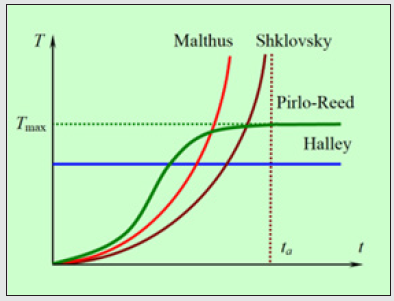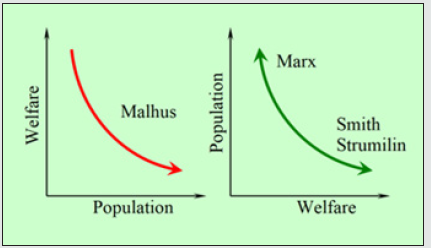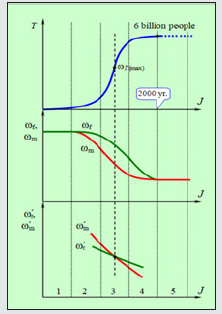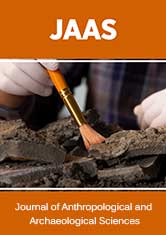
Lupine Publishers Group
Lupine Publishers
Menu
ISSN: 2690-5752
Review Article(ISSN: 2690-5752) 
Interrelation of Models of Socio-Economic Formations and Global Population Growth Volume 4 - Issue 3
Vladimir Sergeevich Grodsky*
- Samara State Polytechnic University, Russia
Received:May 29, 2021; Published: June 16, 2021
Corresponding author:Vladimir Sergeevich Grodsky, Samara State Polytechnic University, Russia
DOI: 10.32474/JAAS.2021.04.000186
Abstract
A new model of historical socio-economic formations, fully presented by the author earlier [1], is briefly and summarized. The connection of this model with a new model of global population growth, developed as a result of a critical analysis of the four most famous demographic models - the Halley, Malthus, Shklovsky and Pearl-Reed models, which were created at different times and are generally united in attempts to select a mathematical function, is revealed. most suitable for displaying only the current mode of population reproduction. It is shown that the reason for the poor quality of these models is their consideration of the size of the human population in the time coordinate. The position is substantiated that the real main factor of population growth should be considered the indicator of the level of institutional and technological development of society, which is proposed to be used in demographic modeling. The correspondence of five phases in the ratio of fertility and mortality of the population to the historical stages of development of social production has been established.
Keywords:Production Technology; ‘Sociology’ of Production; Socio Economic Formation; The Equation of The Economic State of Society; The Level of Institutional and Technological Culture; ‘Demographic Revolution; The Logistic Function of Population Growth; The Economic Law of Population
Introduction
The theory of the German philosopher and economist [2] and the Marxist trend in the development of economic theory turned out to be very fruitful in the issue of identifying qualitatively definite, replacing historical forms of economy, since they were based on universal criteria for the growth of production efficiency and human freedom. However, the incompleteness of Marx’s formational model, its distorted interpretation, the general dogmatic approach to «political economy in a broad sense» in the theory of real socialism, and the subsequent rejection of the practice of ‘building communism’ did not make it possible to create a complete model of changing historical forms of economy. The ideas embodied in Marx’s formational model (Capital: a Criticism of Political Economy. The Process of Capital Production, 1867), in our opinion, have not exhausted their heuristic potential, are currently attracting the attention of economists, but need some development and improvement. supplementing with institutional elements. It is also necessary to revise the system of generalized economic coordinates and indicators of Marx [3]. The fair Marxist thesis that each historical stage in the development of economic activity has special production relations inherent only to it, not only does not exclude, but, on the contrary, presupposes the need to develop universal initial concepts and categories, the use of which makes it possible to trace the development of the natural-social continuum , the continuity of the transition from ‘the economy of nature’ to the ‘nature of the economy’, designated by the classic of political economy, the Englishman Adam Smith (1723-1790) (Inquiry into the Nature and Causes of the Wealth of Nations, 1776).
The “production relations” of people, which are the basis of the economic theory of Marx and are absolutized by him, cannot exist and develop on their own, in their pure form, they are always mediated, materialized. Therefore, the interaction of people with the surrounding nature (production relations of labor) materializes in the means of labor, and the interaction of people with each other (production relations of cooperation) materializes in the means of communication, in social institutions, that is, in the ‘economic mechanism’ in the broad sense of this concept, covering not only economic, but also all other institutions of society [4]. If the instrumentalization of labor mediates the interaction of a person with an external object, then the institutionalization of cooperation orders, regulates and ensures the stability of human life. The means of labor and cooperation are “means of production” in the broad sense of this concept and characterize the level of development of all production relations. In Marxist literature, a person is usually declared a “bearer of production relations,” but in reality the means of production are the material substrate of relations. Man, on the other hand, is the subject of production relations.
An analysis of the duality of production relations and the means of their realization inevitably affects the concepts of “productive forces”, “basis”, “superstructure” and “socio-economic formation”, which Marx considered in detail. First of all, we note that when the concept of “basis” is expanded to include production relations of labor, the concept of “superstructure” is also transformed, since labor relations have their own “superstructure”, their material design in the form of means of labor. We call these means of labor, together with the labor process itself, “technology of production” and consider this concept as the first universal, generalized coordinate “metaeconomics,” as the science of the most general laws of development of social production [5]. This approach of Marx is most concentratedly expressed in the concept of “basis” as a set of relatively stable production relations of society, relations that represent its structure. However, the “superstructure” of society in this case, as we have already noted above, does not contain «basic» institutions. It turns out that the institutionalization of production relations in Marx is outside the economy and society, and the corresponding concepts are outside the subject of economic theory. In reality, the economic superstructure exists in the form of an ‘economic mechanism’ as a material substrate, means of realizing production relations of cooperation, that is, a system of informal customs, principles, norms, rules that regulate and ensure the stability of the economic life of society, developed in the course of economic practice and its cognition. The economic mechanism organizationally formalizes the existing system of production relations of cooperation. One can speak of all the existing institutions of society as an “extended economic mechanism”. This circumstance allows, in general terms, the entire complex of social relations and institutions to be considered a single economic mechanism. In this broad sense, we call it «the sociology of production.» We contrast this concept as the second generalized coordinate of economic theory with the coordinate “production technology”.
Thus, the economic structure of society can be represented using the dualism “technology-sociology of production,” which can replace the triad «productive forces-basis-superstructure» of society and become a more productive tool for understanding the laws of economic development [6]. But these coordinates require their own quantitative measures, which would make it possible to carry out a comparative (comparative) analysis of the historical forms of the economy. To do this, we express the structure of the aggregate product of society in the following form: Q = C + V + M, where C-the natural rent, which contains the overwhelming part of the material costs of production, V-the cost of living labor in monetary terms, and M - the total profit in the form the so-called ‘cash flow’, which includes depreciation and net income. Let’s call the ratio C/V “the level of development of production technology” (P), and the ratio M/V-the level of development of institutions of society, “sociology of production” (S). Both indicators historically as a whole increase, the first-as living labor is replaced by materialized, and the second - due to the increase in the amount of capital goods in the economy, their depreciation and net profit per unit of living labor.
The change in technologies and sociologies of social production in its history occurs in such a way that each of them is not destroyed, but in a transformed form is included in the economic mechanism of a more developed society, that is, the process of “removing” the simple from the complex is observed as the cyclical development of the initial syncretic state of society. Transitions to higher levels of technology and sociology of production also mean the achievement of higher levels of production efficiency, the indicator of which we represent the third absolute historical coordinate (R), measured by the ratio of the volume of the total product Q and resources (W) of society. Therefore, it is possible to write a three-coordinate function expressing the historical trend in the development of production f(P,S,R) in the form of a compact “equation of the economic state of society”: P·S = l·R, where l-the proportionality coefficient, an absolute “economic constant” (Figure 1). The actual trajectory of the development of social production is cyclical (Figure 2).
Figure 2: Historical development of social production in the coordinates ‘Production technology (P) – Sociology of production (S)’.
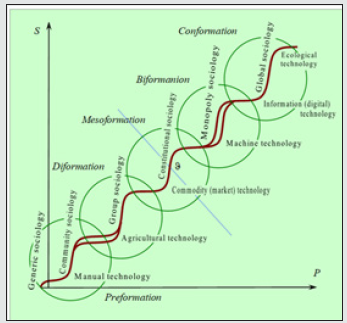
Proportional-disproportionate superwave development of human civilization in the coordinates ‘P-S’, shown in Figure 2, corresponds to Smith’s theory of natural-social continuum (continuity) and Marx’s theory of discrete social development, since the model reflects the possibility of rapid technological advances only with a certain stability of the sociology of production and vice versa. In addition, the model synthesizes the concept of development of a society with an impulse from Marx’s technology with a concept of development with an impulse from the sociology of production by the German sociologist Max Weber (1864-1920) (Protestant Ethics and the Spirit of Capitalism, 1904). Specific historical forms of economic management represent the unity of significant technologies and sociologies of production. In the global wave process, one can distinguish Preformation, Diformation, Mesoformation, Biformation and Conformation, indicated in Figure 2 circles covering specific technology-sociology pairs. Each socioeconomic formation is institutionally determined, has its own distinctive sociology of production, which formalizes its basic technology, but this sociology itself produces a new technology. Thus, all six historical significant technologies turn out to be the connecting links of formations and are located in transition zones (in Figure 2, these zones are located at the overlap of adjacent circles-‘formations’).
The term “preformation” (from the Latin “prae” - ‘in front’) means social ‘primary formation’ containing in syncretic form the structures that predetermine the character of all subsequent formations in history. The Preformation existed on the basis of tribal and communal norms and manual tool production. The subsequent technological dichotomy of the trajectory of the development of society in antiquity on the line of extensive and intensive farming (hence the Greek prefix “di-” in the name of the Diformation) led, respectively, to the slave system and feudalism, which turned out to be economically more efficient; sublease of land. Mesoformation (Greek «mesos» means ‘intermediate’) corresponds to pre-industrial simple commodity production, constitutionally formalized institutions of private capital and free hired manual labor. This historical form of economic management comes to decline in the conditions of proliferation of machine technology in production and the market economy was able to acquire a ‘second wind’ in its further existence only with the transition from classical perfect competition to imperfect, monopolistic competition, which required a new institutional restructuring and increase, thus , the level of development of the sociology of production to “monopoly sociology”.
The 150-year-old modern strip of development of the corresponding Biformation (from the Latin “bis”-twice) represents a monopoly of the first trade, and then of the sphere of production of national economies. Having industrial technology as a determinant, and a mechanism for the implementation of corporatization of capital, that is, duplication of physical capital by financial capital (in the form of securities-stocks and bonds) and splitting the latter into parts of an arbitrary denomination, monopoly provided corporate control of industry markets and the opportunity due to price dictate receiving super-profits. And this superprofit was necessary not so much for additional incomes of entrepreneurs and capital owners, as for the reproduction in the new competitive conditions of industrial capital itself and society as a whole. The subsequent decline in the profitability of market production indicates that this main indicator of the business activity of capital in the process of historical development changes cyclically. This is a sign of not only the strengthening of the homogeneity of the world community, but also the crisis of the industry and the beginning of the transition to post-industrial, information technology, which becomes the basis of the Conformation (the Latin prefix “con-” means ‘together’), in which “global sociology” is formed, then there is a world system of universal institutions that helps to ensure the homogeneity of societies and, in the conditions of the following strictly naturesaving, “ecological technology,” to complete their adaptation to the environment.
The existing natural-social continuum is closely related to demographic processes that have a natural origin and manifestation throughout the historical development of the economy. The population determines the scale and nature of consumption, production, exchange, distribution and accumulation of goods. Therefore, the three absolute economic coordinates introduced by us must be supplemented by generalized demographic coordinates. We will show that the laws of general population dynamics are intertwined with economic laws, and knowledge of the former is important for modeling not only the current functioning of society, but also the main historical forms of production development.
If from all the existing theories of population growth (T) in time t to choose the most famous and compare them, then the following sequence of models is formed (Figure 3):
a) stationary, population unchanged by the English astronomer, mathematician and demographer Edmund Halley (1656 -1742) (Estimation of the Degrees of Mortality of Humanity, 1693).
b) population growth exponentially with a constant growth rate, by the English economist Thomas Malthus (1766-1834) (Essay on the Law of Population, how it Affects the Future Improvement of Society, with Comments on the Reasoning of Mr. Godwin, Monsieur Condorcet and other Writers, 1798 ).
c) population growth according to the hyperbolic law of the Soviet astrophysicist Joseph Shklovsky (1916-1985) (Universe. Life. Reason, 1962).
d) population growth along the logistic curve of Americans, biologist Raymond Pearl (1879-1940) and his collaborator Lovell Reed (On the Rate of Population Growth in the United States Since 1790 and its Mathematical Expression, 1920).
Halley’s constant population model (T = const), which emerged more from his religious beliefs than from facts, is too simplistic even for a period of insignificant population growth in history and generally does not stand up to criticism, but we present its graph only for comparison with other models. We cited the title of Malthus’s Essay entirely from the first edition in order to show its original polemical orientation, a dispute with the ideas of injustice against the poor, vividly shown by the English publicist William Godwin (1756-1836) (Discourses on Political Justice, 1793) and the French philosopher Marie Condorcet (1743-1794) (Sketch of the Historical Picture of the Progress of the Human Mind, 1795). Then Malthus significantly increased his work and in each of the five subsequent editions added the argumentation of his ‘law’, which “consists in the constant striving in all living things to reproduce faster than is allowed by the amount of food at their disposal”. Malthus in his studies set the task of explaining unemployment in a market economy and was, perhaps, the first scientist to consider demographic and economic processes together and in interconnection. For him, the dynamics of the population seemed to be a purely natural-biological phenomenon, supposedly corresponding to a geometric progression (growth according to an exponential law, or, to put it simply, a parabola): dT/dt = const·T. The economy, according to Malthus, can increase the production of “means of life”, including means of employment, only in arithmetic progression, linearly, by virtue of the law of diminishing soil fertility. The resulting imbalance is what causes, according to Malthus, unemployment as an absolute overpopulation of the land. It should be noted that the arithmetic progression of Malthus has not been confirmed, the production of goods in life is ahead of population growth. But, with all the tendentiousness and ideological nature of the economic part of Malthus’s theory, the geometric progression of the human population proposed by him remains very suitable for a significant period in the history of society. The desire to bring the Malthus curve in line with the data of the mid-twentieth century. caused Shklovsky’s proposal to use a hyperbola (T = const/t), which is flatter than a parabola and more accurately models the current global population growth. However, the property of the hyperbola of infinite increase in the variable value as it approaches the asymptote (ta), which, according to calculations, fell on 2030, which was perceived as “the time of the Day of Judgment”, does not allow this model to be considered universal. Since Shklovsky was an astrophysicist and a supporter of the idea of human exploration of outer space by the Russian scientist and inventor Konstantin Tsiolkovsky (1857-1935), then for him there were no fundamental obstacles to the unlimited growth of mankind.
Many scientists specializing in population research have pointed out the fallacy of the idea of unlimited growth of the human population. So the Belgian Adolphe Quetelet (1796-1874) (Man and the Development of his Abilities, or the Experience of Social Physics [5]), who made a great contribution to the formation of demography, pointed to many factors that oppose the growth of the population exponentially, and his compatriot mathematician Pierre Verhulst (1804-1849) took into account the effect of these factors in his logistic curve (dT/dt = (const·T)[(Tmax--T)/Tmax], where Tmax − the maximum possible population of the Earth (‘demographic capacity of the environment’). Pearl and Reed used a similar realistic approach to the selection of a generalized demographic function. They proceeded from the existence of an ethological (behavioral) and spatial limitation of population growth. Using experimental data on the dynamics of the fruit fly population, they again considered it possible to transfer biological laws to social science. However, the results of calculations by Pearl and Read turned out to be quite adequate to the actual data. The logistic curve not only satisfactorily described the historical dynamics of the population, but also quite realistically predicted deceleration of growth and stabilization of the population. The Pearl-Read model is of a synthetic nature, its individual sections correspond to the other three functions of demographic growth discussed above. Population dynamics is the most multifactorial, complex process, which in some cases is characterized by both the coincidence of parameters for different reasons, and, conversely, their mismatch under similar circumstances. But this does not mean that there is no general law of population growth. Unfortunately, an accurate demographic model has not yet been created.
Pearl and Read, like many other authors, are forced to dominate the mathematical approach, the desire to simply choose the most accurate ‘growth curve’. Therefore, checking the model for a long period of time after the 20s. showed its inaccuracy. Within the framework of the concept of «global demographic transition» proposed by the French researcher Adolphe Landry (1874-1956) (Demographic Revolution, 1934), two of its key parameters varied in the Verhulst-Pearl-Reed equation: 1) maximum population Tmax; 2) ‘constanta of Malthus’, which was taken as a variable, and its maximum value characterized the point of symmetry of the logistic curve and the calendar date of the change in the regime of population reproduction. All these modifications of the equation do not cancel its general nature, but, again, they consist in the selection of more modern parameters. The equation can take a complete form, in our opinion, only when replacing the neutral, not ‘working’ coordinate of time with some economic coordinate, which would generally express the effect of the main factor of the dynamics of both the population of mankind itself and its components − fertility and mortality. Malthus considered the economy as a derivative of the demographic sphere. Therefore, the welfare of society was the inverse function of population growth (Fig. 4, left). Marx, being one of the main opponents of Malthusianism, argued the opposite, that demographic processes depend on economic activity, pointed to the presence of the opposite direction of the economic and demographic process, when “poverty ... favors reproduction” (Figure 4). Thus, Marx interchanges «Population» and its «Welfare» in their causal relationship, pointing out that “not only the number of births and deaths, but also the absolute size of families is inversely proportional to the height of wages ...”[2]. These are the same variables Smith had in mind when he described the reverse process: “The infertility so common among secular women is very rare in women from the lower strata of the people. Luxury, perhaps, generates a passion for pleasure in a beautiful field, but, apparently, it always weakens and often completely destroys the ability to bear children” [3]. Later, in the conditions of the growing well-being of the population of the USSR, the Soviet economist Stanislav Strumilin (1877-1974) concluded that the birth rate was declining (Problems of Labor Economics, 1957) [4]. The indicator “social welfare” is bad because, firstly, it contains population T in the denominator in the form of average per capita income, which is considered as a separate variable in the models, and secondly, with high income differentiation, it can neutralize multidirectional demographic processes.
Marx believed that “every historically specific mode of production is in fact characterized by its own specific laws of population that have a historical character” [2]. But he formulated only the law of population of bourgeois society, according to which “the working population, by accumulating capital, thereby in increasing amounts produces means that make it a relatively surplus population”. The development of the market did not confirm the thesis about the tendency of the «impoverishment of the proletariat» and, nevertheless, according to the Soviet demographer Boris Urlanis (1906-1981), employment is the operation of the laws of population not only of capitalism, but also of socialism, feudalism and even slavery [5]. However, ‘relative overpopulation’ as well as socialist ‘general employment’ should be considered purely economic phenomena. Marx rejected the existence of any general laws of population development, pointed out that “the abstract law of population exists only for plants and animals” and only as long as “until man historically invades this area” [2]. But this provision is contradicted by demographic data. How to combine the obvious specifics of population reproduction in different historical epochs with the existence of a single law of logistic growth of the human population? To answer this question, let’s take a closer look at the Pearl-Read model. With all its quantitative imperfections, it contains a whole set of alternating alternately different qualities of the population, which can be considered as formational laws of population, if the time indicator t is replaced by a monotonically increasing indicator ‘level of production culture’ J, which we introduced above into the equation R = k·J. The extremely generalized indicator J characterizes well the shifts in productive forces and the need for human resources in the history of the economic development of society, reflects not only technological, but also institutional factors of population dynamics.
In Figure 5 shows a marginal economic model of population growth T = f(J). Its upper graph is integral, it shows the curve of the total population until 2015 and its long-term forecast, according to the logistic law. The average, differential, graph of the model shows the fertility rate (ωf, ωf = = dTf/T) and mortality (ωm, ωm = dTm/T) of the population. Since the logistic function itself contains qualitatively different combinations of fertility and mortality, the entire period of development of society, which means the demographic transition from the initial primitive regime of population reproduction to the modern one, can be divided into five historical formations (stages, phases). The first formation of the demographic transition, called the “archetype” of population reproduction and attributable to the weak development of the culture of production, is characterized by an approximate equality of birth and death rates, although these parameters themselves were high in this formation. Such a ratio of factors on the integral graph of the model corresponds to a long period of almost unchanged population.
The second qualitative formation of the demographic development of society reflects the preservation of the birth rate at a high level and the beginning of a certain decrease in mortality, which can be attributed to a certain growth in the culture of social production and success in medicine. This fork in fertility and mortality accounts for a marked increase in population. The third, culminating and transitional formation of the dynamics of mankind is distinguished by a decrease in both mortality and fertility, the difference between them reaches a maximum. This moment of development of the process in the integral part of the model corresponds to the point of the maximum rate of population growth (ωT(max)) during the industrialization of the world’s economies. This symmetrical point divides the logistic function into ascending and descending branches. The fourth, modern, formation of the demographic transition, which falls on the information culture of production, is characterized by the stabilization of mortality at a level achievable under current conditions and a further decline in the birth rate. Such a combination of these factors, symmetrically opposite to the second formation, means a slowdown in the growth of the total population. Finally, the fifth formation, called the “neotype” of population reproduction and being predictive, denotes the equality of low parameters of fertility and mortality on the differential graph of the model, and on the integral graphthe constant size of the human population. Since the specific type of function of demographic growth, which describes its prehistory and prospects, depends on the location and value of the point of symmetry of the logistic curve, the model provides for the determination of derivatives of fertility and mortality of the population (ώf, ώm). The intersection point of these marginal values on the third, lower, graph of the Figure 5 allows obtaining the necessary accurate data on the level of production culture and the chronological date of the ‘demographic revolution’ in the history of society (dashed vertical line in the third formation of the model). In general, the indicated stages of population development, as will be shown below, correspond to certain historical forms of economic management.
References
- Malthus T (1992) Experience on the law of population. Anthology of economic classics 2(10).
- Marx K, Engels F (1955-1982) Works.
- Smith A (1935) Research on the nature and causes of the wealth of peoples 2(11).
- (1957) Strumilin SG Problems of labor economics.
- Economic encyclopedia. Political Economy.
- Grodskiy VS (2020) Digital Economy-Information Era: Retrospective Analisis. Digital Transformation of The Economy: Challenges, Trend and Nev Opportunitits. Cham pp: 163-

Top Editors
-

Mark E Smith
Bio chemistry
University of Texas Medical Branch, USA -

Lawrence A Presley
Department of Criminal Justice
Liberty University, USA -

Thomas W Miller
Department of Psychiatry
University of Kentucky, USA -

Gjumrakch Aliev
Department of Medicine
Gally International Biomedical Research & Consulting LLC, USA -

Christopher Bryant
Department of Urbanisation and Agricultural
Montreal university, USA -

Robert William Frare
Oral & Maxillofacial Pathology
New York University, USA -

Rudolph Modesto Navari
Gastroenterology and Hepatology
University of Alabama, UK -

Andrew Hague
Department of Medicine
Universities of Bradford, UK -

George Gregory Buttigieg
Maltese College of Obstetrics and Gynaecology, Europe -

Chen-Hsiung Yeh
Oncology
Circulogene Theranostics, England -
.png)
Emilio Bucio-Carrillo
Radiation Chemistry
National University of Mexico, USA -
.jpg)
Casey J Grenier
Analytical Chemistry
Wentworth Institute of Technology, USA -
Hany Atalah
Minimally Invasive Surgery
Mercer University school of Medicine, USA -

Abu-Hussein Muhamad
Pediatric Dentistry
University of Athens , Greece

The annual scholar awards from Lupine Publishers honor a selected number Read More...





